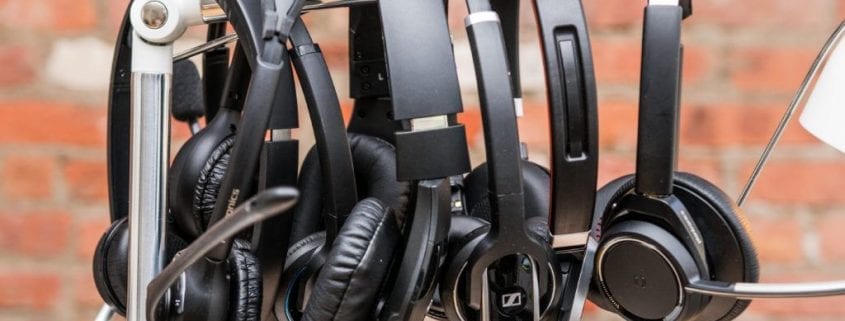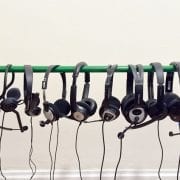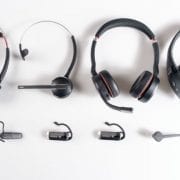How do you choose the right headsets for your organization? Part III
Series by Danny Hayasaka
In Part I of this series we discussed who the top headset manufacturers are and why. In Part II we covered why it’s important to choose an Authorized Partner. Now…let’s get into it. How do you choose the right headsets for your organization?
Back in the day, it was so simple; Plug Prong or Multipurpose Amp, single ear, dual ear or convertible wearing style headset. That’s it.
Today the landscape is more complex. How people work, where they work, what devices they use vary greatly from role to role. Leading headset manufacturers offer very broad portfolios that support the many personas, environments, voice, video and collaboration platforms that exist today.
Personas/Use Case/Work Style
Organizations are made up of several different roles. The various roles determine the type of calls, duration of calls and what a person utilizes throughout their day to communicate and collaborate. It’s important to understand the various personas throughout the organization and be able to categorize them. This is one of the most important exercises to go through as this will provide a starting point to the selection process. The headset manufacturers have done much research in this area. They offer multiple persona types identified by role, work style, call types, devices, and environment. An authorized partner can help you categorize the various personas. Here are a few Persona examples:
(From Plantronics) Persona: Flex Worker
The flex worker splits time between the corporate office, a home office, and travel. They are always innovating and adapting their communications channels. They embrace social media and enjoy using new technology. Due to frequent remote and on-the-go work, pain points include difficulty collaborating with colleagues and missing important information in the office. The flex worker needs to be “always-on” and communicate across several devices.
Occurrence in a typical enterprise: 16%
UC usage/adoption: High
(From Plantronics) Persona: Office Communicator
As a more traditional work style, the office communicator is most comfortable with familiar systems and devices (like a desk phone). Due to the high percentage of time they spend communicating in the office, their pain points include being diverted by interruptions, background noise and lack of privacy on calls.
Occurrence in a typical enterprise: 17%
UC usage/adoption: Low
(From Jabra) Persona: The Advisor
The advisor conducts more complex conversations with customers over the phone. Often relying on both systems as well as the assistance of other specialists in the office to get the case resolved this profile is more internal mobile. They often operate in smaller office settings with fewer colleagues around them however challenges around noise and distractions also impacts these profiles. They are in the need for professional communication tools delivering outstanding call quality build for all day usage. Solutions offering wireless mobility in order to reach out to other subject matter experts while on the call with customers is also of critical importance to these profiles.
Comms need: Desk / Softphone, PC, Email, In-person
(From Jabra) Persona: Mobility Dependent
Mobility dependent users have no fixed location but instead are dependent on constantly being mobile for their living. Typical examples of professions within this group are professional drivers, be it day drivers, short or long haul delivery type, or taxi/chauffeur type driving. Usually, these archetypes operate in high noise environments and are regulated by law with regards to safe communication and operating a vehicle. Hands-free communication is vital as a means to communicate with their central dispatch, delivery customer or simply stay connected over long travel periods.
Comms need: Smartphone / tablet
It’s critical users have the right headset for their role so they can focus on being the best they can be. Departments differ in what they do. For example, a Contact Center vs Mobile Sales Team use different communications tools and the environments are definitely not the same. We recommend leaders and managers of the various business units and departments create a list of the various roles and devices used to start the selection process.
Environment
Where people work includes multiple environments: private offices, cubicle jungles, open office spaces, shared work stations (Hoteling, Hot Desking, and Flex Stations), home offices, data centers, warehouses, airport terminals, trains, trucks, cars, hotel rooms and lobbies, coffee shops, parks, etc.
Different environments affect noise levels. Noise levels are increasingly becoming a major factor in headset selection. All brands claim to have “noise canceling mics” however some mics better than others at suppressing background noise. “Active Noise Canceling” (ANC) technology is now available with some Plantronics, Jabra, and Sennheiser models. Trends in “open offices” and “work anywhere” scenarios have created a need for ANC technology to help users block out noise distractions and focus on completing tasks.
Voice, Video and Collaboration platforms
Most organizations have hybrid environments made up of multiple platforms. They may have Cisco desk phones, Skype for Business on their PCs/Laptops, and have Zoom video collaboration meetings. And don’t get me started with mobility. It’s important to understand ALL the specific platforms in use: Cisco, Microsoft, Zoom, etc. as well as all the various devices utilized by the various personas: Desk Phone, PC/Laptop and/or Mobile Device/s. More importantly, know what each persona type utilizes to communicate throughout the day to perform their role.
Personal Wearing Style
Headsets are like blue jeans. Individuals have that one pair of jeans that fits and feels just right. Each brand offers multiple wearing styles from a headband, behind the neck, over the ear, and in the ear options. One size does NOT fit all when it comes to headsets. Use case, environments, and personal preference will dictate wearing style. Size of head, hair type, and hairstyle, bald head, shape, and size of ears, hearing impairment and other physical disabilities are all things to consider when choosing headsets.
Security
Information sensitivity levels during voice calls vary by organization. Security is critical in industries like Finance, Healthcare, Insurance, and Government. Plantronics, Jabra, and Sennheiser all offer solutions that include the highest levels of security in their wireless products.
Plantronics DECT 6.0 Wireless Security Statement
Jabra Technical Whitepapers Link
- Includes DECT and Bluetooth Security Whitepapers
Sennheiser Communication Security Blog
Headset Management Software
Asset Management is becoming increasingly more important. Beyond knowing what, how many and who has headsets, IT teams need greater abilities to manage and support headsets. Headset Management Software comes in two flavors: Individual downloads or Enterprise grade software that can be managed remotely. Headset Management Software provides a variety of options and allows for the customization of the user experience. It also helps mitigate or eliminate headset issues before they arise. If selecting enterprise headset software, organizations need to identify “who” will be managing. This can be challenging with larger global enterprises.
Individual Downloads:
Plantronics Downloads and Apps
Jabra Suite for Mac – Individual or Mass Deployment
Enterprise Headset Software
Plantronics Manager Pro (Subscription Service)
Jabra Xpress (Free)
Sennheiser HeadSetup Pro Manager (Subscription Service)
Power, USB, space, and portability
I personally have been onsite for headset deployments and installs. One issue we’ve run into is not having enough power outlets or USB ports. Make certain there are enough power outlets and USB ports available to support all the devices (i.e. Headsets, Webcams, USB Speakerphones, USB Busy Lights, Mobile device chargers, Printers, coffee cup warmers, etc.). USB-C headsets are now available options. Has your organization started the migration to USB-C? If multi-connectivity headsets are selected, the proximity of desk phone vs PC/Laptop also need to be considered. Some workstations have limited space so you need to be cognizant of how much space a headset will take, especially a wireless headset that requires a base. How portable is the headset? Does it include a carry case? This is important for those who share work stations and need to pack up their headset when they leave. In addition to a headset, they may also have to pack up and carry a laptop, docking station, keyboard, mouse, webcam, etc. Point is, the easier to transport the headset, the better.
Training-Y
I’m making this a topic because customers continue to ask if there is a way to connect TWO USB Headsets into one PC for training purposes. The answer is still no. It’s important to understand if your organization needs training-y or buddy jack scenario. There are different solutions for these scenarios. Some organizations transition to Softphone only and purchase hardwired USB only headsets only to find there is no training-y. I have a couple of blogs on this topic.
Is there a Training-Y for USB Headsets?
Can you connect two hardwired USB headsets?
YES, manufacturers still make Training-Y’s for their corded QD Headsets. Audio Processors like the Jabra Link 860 include Supervisor port. Most DECT wireless headsets include the “Conference” feature which supports up to 4 wireless headsets to be paired to the same base. This feature is commonly used for “training” purposes.
Accessories
Most business-grade headsets have a laundry list of available accessories like ear cushions, mic screens, voice tubes, ac adapters, cables, USB cables, USB dongles, batteries, ear hooks, neckbands, headbands, busy lights, lapel clips, ear tips, etc. There are multi-shift wireless headset charging stations available for some models. In work environments that operate 24/7 and need to be wireless, that’s good to know.
Many consumer headsets don’t have available accessories so if you lose an ear cushion, you’re out of luck.
Some organizations share headsets! (We don’t recommend) Availability of affordable accessories is a huge factor in headset selection. Not all wireless headsets support field replaceable battery. That’s important to understand prior to selecting.
What headset accessories will your organization need?
Budget
Often budgets are created prior to the headset selection process. This can cause delays further down the road. If you didn’t know… Headsets cost money. The cost varies from model to model. A reminder that persona determines which headset is best. A mobile persona who utilizes primarily mobile phone cannot perform optimally with a corded USB headset. An office mobile person who needs to be available to take calls while away from their desk benefits more from a wireless headset. Most brands offer good, better, best options. The point is, organizations should engage an authorized partner early in the planning stage to more accurately identify a headset budget.
Roadmap
Are there any significant changes coming to your voice, video and collaboration platforms? When are those changes coming? Who will be affected? It’s important to understand where you are today and where you are going. Some headset options are good now, however, may not support where you are going. Your authorized vendor can coordinate quarterly roadmap meetings to discuss any changes in your landscape along with the manufacturers. This may require signed NDA however it’s extremely important when it comes to planning and budgeting.
Conclusion
Choosing the wrong headsets can be very detrimental to your organization in many areas like productivity, new UC, voice, video and collaboration platform adoption, employee and customer satisfaction levels.
While price should be a factor, it should NOT be the only factor. How people work, what people need daily to communicate and collaborate to succeed in their roles should be a primary factor.
Unless you go to headset school like Authorized Resellers, identifying and selecting the right headsets can be extremely overwhelming. Across the major brands, there are over 70 wireless headset models to choose from not including Microsoft variants. There are NEW headsets being introduced regularly. There are a variety of connectivity options available depending on the various personas.
Don’t tackle this alone. Get help, advice, and guidance from a subject matter expert who is authorized and certified like Call One, Inc.







Leave a Reply
Want to join the discussion?Feel free to contribute!